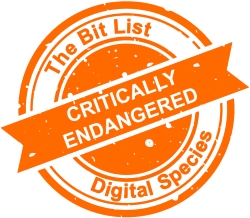Pre-WWW ViewData and TeleText Services where no Archival Agency has Captured and Retained the Signal
|
|
 |
|
|
Pre-WWW television information services broadcast within the TV signal that allowed a degree of search and retrieval of up-to-date information, based on Teletext or ViewData technologies and variants. |
||
|
Digital Species: Sound and Vision |
Trend in 2023:
|
Consensus Decision |
|
Added to List: 2017 |
Trend in 2024:
|
Previously: Critically Endangered |
|
Imminence of Action Immediate action necessary. Where detected should be stabilized and reported as a matter of urgency. |
Significance of Loss The loss of tools, data or services within this group would impact on many people and sectors. |
Effort to Preserve | Inevitability It would require a major effort to prevent or reduce losses in this group, possibly requiring the development of new preservation tools or techniques. |
|
Examples AerTel; Electra; MetroText; Antiope-based systems; Ceefax; TeleText. |
||
|
‘Practically Extinct’ in the Presence of Aggravating Conditions Lack of understanding; structure of information silos; lack or loss of documentation; uncertainty over IPR or the presence of orphaned works; lack of funding or impetus. |
||
|
‘Endangered’ in the Presence of Good Practice Captured within on-air broadcast recordings; active research and recovery programme. |
||
|
2023 Review This entry was added in 2017, with a number of important developments reported since, raising hope that collections can be recovered and reused under certain circumstances. In particular, the development and on live capture of broadcast output at the BBC and British Film Institute noted by 2018 and 2019 Bit List Juries. Embedded signals can be assembled to access the Teletext content, and methods to recover such signals have been demonstrated (where the appropriate broadcast archive exists). In 2019, a proposal to add teletext graphics characters to the Universal Coded Character Set was also accepted, making it easier to transmit and archive teletext and legacy computer graphics for archiving and preservation. Version 13.0 of the Unicode Standard, released in March 2020, included the addition of graphic characters that provide compatibility with early teletext broadcasting standards. For these reasons, the 2020 Jury identified a 2020 trend towards reduced risk. The 2021 Jury identified a 2021 trend toward more reduced risk. They noted that while not yet fully clear how such a signal could be made searchable or made available at scale, research had progressed with different threads of research and enthusiast and community-led initiatives being brought together in the development of preservation tools and techniques. In light of those these developments and active research and recovery efforts, the 2021 Jury additionally supported a change from the Practically Extinct to Critically Endangered classification. The 2022 Taskforce agreed on the classification with risks remaining on the same basis as before, with no change to the trend. The 2023 Council noted there may be a lower significance of the digital material of this entry than the previous 2021 Jury but agreed with the Critically Endangered classification with overall risks remaining on the same basis as before (‘No change’ to trend). |
||
|
2024 Interim Review These risks remain on the same basis as before, with no significant trend towards even greater or reduced risk (‘No change’ to trend). |
||
|
Additional Comments From a cultural studies point of view, it is a huge loss: an important source of information about news and social mores of the time. Is there progress to report on this entry, meaning that elements of the problem have been resolved? Major national agencies have collections of off-air recorded television on videotape carriers, which are likely to contain the teletext data. Few, if any, have undertaken substantial extraction and preservation of the teletext in its own right. However, many have digitized videotape carriers to digital file formats, which are now under preservation. An active Teletext enthusiast community has developed and created programmatic solutions to extract the teletext from the video files and emulation of the teletext display. A next step could be a collaboration between the official agencies and the enthusiast community to develop a systematic programme to extract teletext from off-air recordings for both preservation and access via emulation. See also:
|
||











































































































































